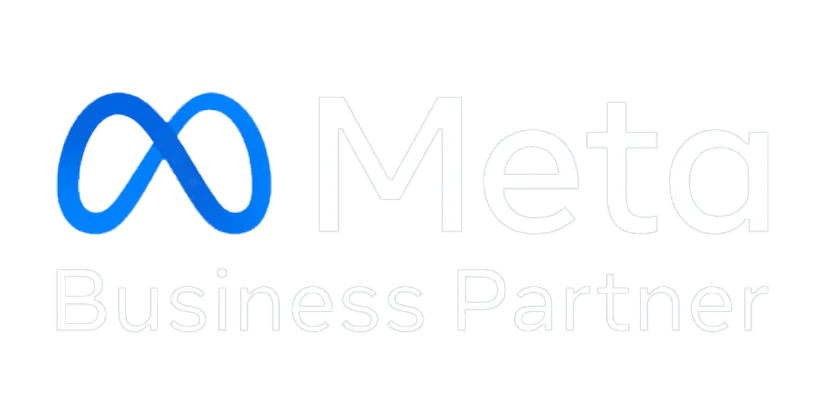WhatsApp Drip Campaigns: A Game-Changer for D2C Marketing Strategies
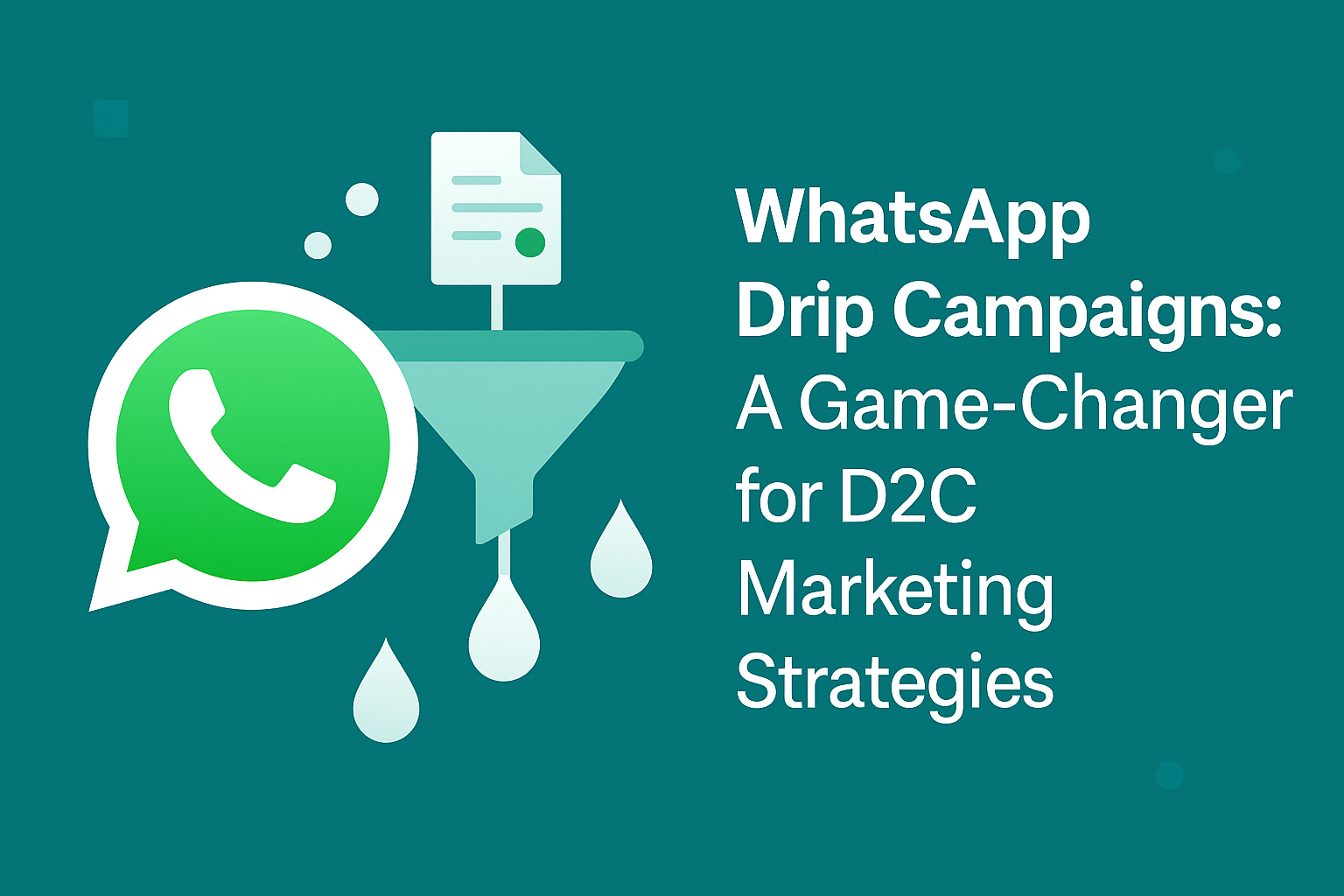
Introduction In the competitive landscape of Direct-to-Consumer (D2C) brands, capturing and retaining customer attention is paramount. Traditional marketing channels often fall short in delivering personalized and timely messages. Enter WhatsApp drip campaigns—a dynamic tool that enables brands to engage customers through automated, personalized messaging sequences. Understanding WhatsApp Drip Campaigns What is a WhatsApp Drip Campaign? A WhatsApp drip campaign is a series of automated messages sent to customers over time, triggered by specific actions or timelines. These campaigns aim to nurture leads, onboard new users, or re-engage existing customers with personalized content. Benefits Over Traditional Channels Why WhatsApp is Essential for D2C Brands Vast User Base With over 2 billion active users globally, WhatsApp provides an unparalleled platform for reaching diverse demographics. In markets like India, WhatsApp has become an integral part of daily communication. Enhanced Customer Engagement WhatsApp enables two-way communication, allowing brands to interact with customers in a more personal and conversational manner. This fosters trust and loyalty, essential components for D2C success. Setting Up a WhatsApp Drip Campaign Step 1: Define Campaign Goals Identify the objective of your campaign—be it onboarding, re-engagement, or upselling. Clear goals will guide the content and structure of your messages. Step 2: Segment Your Audience Divide your customer base into segments based on behavior, purchase history, or demographics. This ensures that messages are relevant and personalized. Step 3: Craft Personalized Messages Develop message sequences that resonate with each segment. Incorporate customer names, past interactions, and tailored offers to enhance engagement. Step 4: Utilize Automation Tools Leverage WhatsApp Business API and automation platforms to schedule and send messages efficiently. Tools like The BotMode can streamline this process. Step 5: Monitor and Optimize Track key performance indicators (KPIs) such as open rates, click-through rates, and conversions. Use this data to refine your campaign for better results. Best Practices for Effective WhatsApp Drip Campaigns Obtain Explicit Consent Ensure compliance with data protection regulations by obtaining clear consent from users before sending messages. Personalize Content Use customer data to tailor messages, making them more relevant and engaging. Optimize Timing and Frequency Schedule messages at times when customers are most likely to engage, and avoid overwhelming them with too many messages. Incorporate Rich Media Enhance messages with images, videos, or interactive elements to capture attention and convey information effectively. Test and Iterate Conduct A/B testing to determine what content and timing work best, and continuously refine your strategy based on results. Measuring Success and ROI Key Metrics to Track Tools for Analysis Utilize analytics tools compatible with WhatsApp Business API to gather insights and inform future campaigns. Conclusion WhatsApp drip campaigns offer D2C brands a powerful avenue for personalized, timely, and effective customer engagement. By leveraging automation, segmentation, and data-driven strategies, brands can enhance customer experiences and drive conversions. Ready to revolutionize your D2C marketing strategy? Explore how The BotMode can help you implement successful WhatsApp drip campaigns today. FAQs Q1: What is a WhatsApp drip campaign? A WhatsApp drip campaign is a series of automated messages sent to customers over time, based on specific triggers or schedules, aimed at nurturing leads or engaging customers. Q2: How can D2C brands benefit from WhatsApp drip campaigns? They enable personalized communication, higher engagement rates, and improved customer retention, leading to increased sales and brand loyalty. Q3: What tools are needed to set up a WhatsApp drip campaign? You’ll need access to the WhatsApp Business API and an automation platform like The BotMode to manage and schedule messages. Q4: Are there compliance considerations for WhatsApp marketing? Yes, it’s essential to obtain explicit consent from users and adhere to data protection laws and WhatsApp’s business policies. Q5: How do I measure the success of my WhatsApp drip campaigns? Track metrics such as open rates, click-through rates, conversion rates, and customer retention to evaluate performance and make informed improvements.
Top 10 WhatsApp Broadcast Ideas That Drive Sales for D2C Businesses

Why WhatsApp Broadcasts Matter for D2C Brands In the fast-paced world of D2C marketing, WhatsApp has evolved into a high-conversion sales channel. With an open rate exceeding 90%, strategic WhatsApp broadcasts can significantly enhance customer engagement and boost revenue. At TheBotMode, we enable D2C brands to automate and scale their WhatsApp marketing using the official WhatsApp Business API. Below are 10 high-performing WhatsApp broadcast ideas designed to help you increase sales in 2025. 1. New Product Launch Announcements Generate anticipation and drive immediate traffic with sneak peeks and early access links. Use rich media like images or short videos to showcase new products. Example Message: Just launched: Our new summer collection is now live. Limited stock available. Shop now: [Link] Why it works: Early announcements create a sense of exclusivity, prompting quicker decisions and driving impulse purchases. 2. Limited-Time Offers and Flash Sales Create urgency with time-sensitive deals. Clearly mention the discount and the time limit to drive immediate action. Example Message: Flash Sale: Get 30% off for the next 6 hours. Don’t miss it: [Link] Pro Tip: Use TheBotMode’s scheduling feature to send these messages during your brand’s peak engagement hours. 3. Back-in-Stock Alerts Notify customers when previously sold-out products are available again. This is highly effective for interested or waitlisted buyers. Example Message: Back in stock: Our best-selling oversized tee is available again. Order now before it sells out: [Link] Why it converts: It targets high-intent users who have shown interest earlier. 4. Exclusive Discounts for VIP Customers Build loyalty by offering special deals to your top customers. It can also include early access to sales or limited-edition products. Example Message: Thank you for being a valued customer. Enjoy 20% off sitewide with code VIP20. Shop here: [Link] Why it works: Recognizing and rewarding loyalty increases customer retention and lifetime value. 5. Abandoned Cart Reminders Recover lost sales with automated reminders that include images, product names, and links. Example Message: You left something in your cart. Complete your order before it’s gone: [Link] Boost It: Include a time-limited discount code to increase urgency. 6. Festival and Seasonal Greetings with Offers Use festivals and seasons as natural sales opportunities. Tie them to exclusive offers or limited collections. Example Message: Happy Diwali. Celebrate with 25% off on festive collections. Offer valid today only: [Link] Why it’s smart: Customers are more willing to shop during festive periods and holidays. 7. Customer Reviews and Social Proof Leverage positive customer reviews or user-generated content (UGC) to build trust. Example Message: Here’s what our customer Sneha said about our embroidered kurtis: “Absolutely stunning. I received so many compliments.” Check it out: [Link] Why it works: Real reviews reduce buying hesitation and increase confidence. 8. Weekly Product Highlights Feature trending products, bestsellers, or editor’s picks to keep users engaged weekly. Example Message: Top Picks This Week: Oversized T-shirts, Cotton Kurtis, and more. Explore now: [Link] Bonus: Use carousel images to increase visual interest. 9. Order Updates with Upsell Opportunities Send transactional updates like order confirmation and delivery alerts, paired with smart cross-sell suggestions. Example Message: Your order has been shipped. Meanwhile, check out these accessories that pair well with your purchase: [Link] Why it works: Customers are highly engaged after placing an order and are more likely to respond to related product recommendations. 10. Polls and Feedback Requests Engage your audience while collecting insights. Offer a small incentive for completing surveys or polls. Example Message: Help us improve by taking a short 1-minute survey. Receive 10% off your next purchase. Start here: [Link] Why it works: Encourages interaction while gathering valuable feedback to improve your offerings. Final Thoughts WhatsApp broadcasting is one of the most underutilized yet powerful marketing tools for D2C brands. When done right—with personalization, timing, and value—it drives conversions and builds lasting customer relationships. At TheBotMode, we simplify WhatsApp marketing using the official Business API. Whether you’re launching a collection, recovering carts, or re-engaging dormant users, our platform helps you drive real results through smart automation and insights. FAQs Q1. What is a WhatsApp broadcast? A WhatsApp broadcast allows you to send a message to multiple users simultaneously without creating a group. Only users who have saved your number will receive the message. Q2. Is WhatsApp broadcast free to use? Yes, if you use the WhatsApp Business App. However, the WhatsApp Business API (which supports large-scale or automated sending) may have associated messaging costs. Q3. Can I personalize WhatsApp broadcasts? Yes. With TheBotMode’s WhatsApp API integration, you can personalize messages using customer names, cart contents, and more. Q4. How many users can I broadcast to on WhatsApp? The WhatsApp Business App allows up to 256 contacts per broadcast. With the API, you can send broadcasts to an unlimited number of users based on your plan. Q5. How do I track the performance of WhatsApp broadcasts? Track metrics such as open rate, click-through rate, responses, and conversions. TheBotMode provides real-time analytics to help optimize your campaigns. Book a Free Demo with TheBotMode
🛍️ How D2C Brands Can Use WhatsApp to Boost Repeat Purchases
For D2C brands, acquiring customers is just the beginning — the real growth lies in keeping them. And in 2025, WhatsApp is one of the most powerful tools to drive repeat purchases with higher ROI than email or SMS. Let’s explore how D2C brands can turn one-time buyers into loyal customers using WhatsApp effectively. 🔄 Why Repeat Purchases Matter for D2C Brands ✅ WhatsApp Strategies That Drive Repeat Orders 1. Automated Post-Purchase Messages Right after a successful order, send: Example: “Thanks for shopping with us, Priya! Your order is on the way. You’ve unlocked ₹100 OFF on your next order. Tap below to redeem.” → [Button: Use ₹100 OFF] 2. Reorder Reminders Based on Product Lifecycle For consumable products (protein, skincare, pet food): Example: “Running low on your protein shake? Refill now and get 10% OFF.” → [Button: Reorder Now] 3. Personalized WhatsApp Broadcasts Instead of generic offers: Tip: Use TheBotMode’s smart segment feature to automate this easily. 4. Loyalty & Cashback Campaigns Encourage repeat shopping through: Example: “You’ve earned ₹50 Cashback on your next order. Tap to claim.” → [Button: Claim Cashback] 5. Exclusive Access & Early Drops Create FOMO and brand love by: Example: “👀 VIP Access: Our new Glow Serum is live only for you. Get it before the rest.” → [Button: Buy Now] 📈 Results You Can Expect D2C brands using WhatsApp effectively report: 🚀 How TheBotMode Makes It Easy TheBotMode offers: All without any coding, directly inside your Shopify or WooCommerce store. 🎯 Final Thoughts Repeat customers are your most valuable asset — and WhatsApp is the key to unlocking their full potential. If you’re a D2C brand not using WhatsApp for retention yet, you’re leaving serious revenue on the table. Ready to automate repeat purchases on WhatsApp?Book a Free Demo with The Botmode
Top Metrics to Track WhatsApp Marketing ROI in 2025
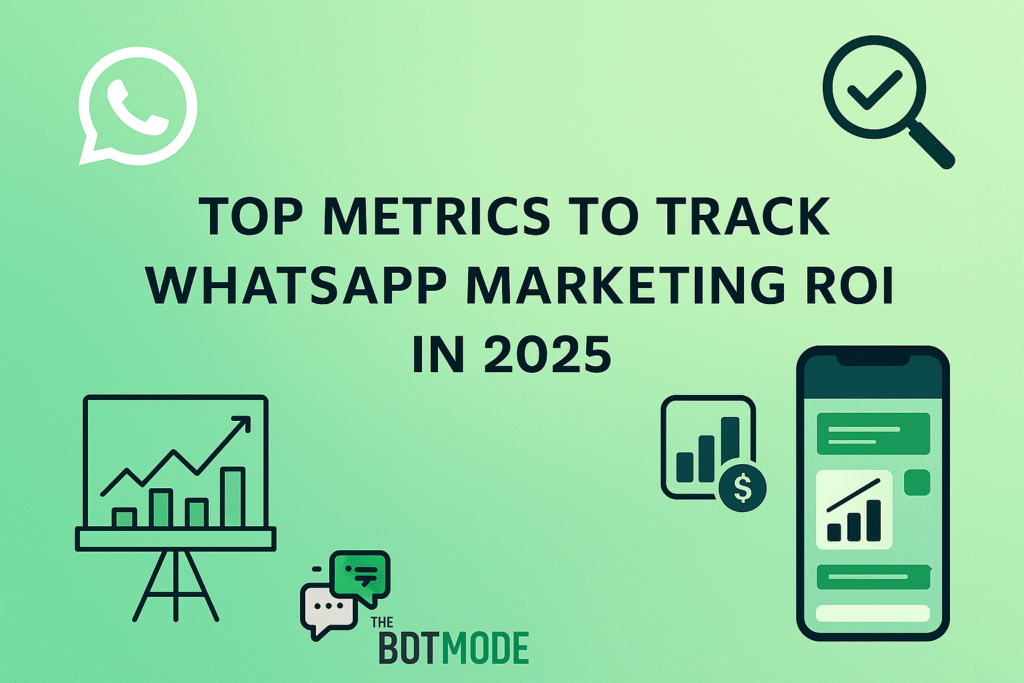
In 2025, data-driven marketing is no longer optional—it’s essential. As WhatsApp Business API becomes a dominant platform for D2C engagement, tracking WhatsApp marketing ROI helps you prove value, optimize performance, and scale efficiently. Whether you’re running broadcasts, drip campaigns, abandoned cart alerts, or support automation, these metrics will give you clarity and control over your WhatsApp performance. 1. Conversion Rate from WhatsApp Campaigns Why it matters: Conversion is the ultimate metric—whether it’s a sale, sign-up, or lead. This directly reflects ROI. Track: How The Bot Mode helps: With seamless Shopify, WooCommerce, and CRM integrations, you can trace every message back to revenue. 2. Message Open Rate Why it matters: WhatsApp messages outperform email with open rates above 90%. Still, tracking them helps optimize timing and templates. Track: Tip: Test send times and formats to improve open rate benchmarks. 3. Engagement Rate (Replies & Clicks) Why it matters: Engagement indicates trust and interest—core to conversion. Track: The Bot Mode Advantage: Our drag-and-drop builder visualizes flows, so you can pinpoint where users interact—and where they leave. 4. Retention and Repeat Interaction Rate Why it matters: Repeat engagement reflects real value and long-term ROI, not just one-time wins. Track: Use Case: If users reorder within 30 days of a WhatsApp nudge, that’s measurable ROI. 5. Cost per Acquisition (CPA) via WhatsApp Why it matters: CPA reveals efficiency—what you’re spending to get each new customer. Track: With The Bot Mode: You get real-time CPA dashboards and can automate retargeting to keep acquisition costs low. 6. Funnel Completion Rate Why it matters: From lead capture to purchase, funnel metrics show drop-off points and conversion health. Track: Optimization Tip: Trigger automated follow-ups for users who drop off midway. 7. Customer Satisfaction Score (CSAT) Why it matters: Happy users stay longer and convert more. CSAT helps measure the customer experience in real time. Track: Pro Tip: Use satisfaction triggers after support conversations or post-purchase flows. Why Choose The Bot Mode for WhatsApp Marketing ROI? At The Bot Mode, we don’t just help you send messages—we help you track, test, and scale them. Our tools include: With The Bot Mode, you’ll know what’s working—and why. Final Thoughts In 2025, WhatsApp marketing isn’t just about communication—it’s about conversion. With the right metrics and tools in place, you’ll scale your brand faster and smarter. Ready to track your WhatsApp marketing ROI with precision? FAQs Q1: What is a good ROI for WhatsApp marketing? A good ROI varies by industry, but D2C brands typically achieve 5x to 10x returns when flows are optimized with conversion tracking. Q2: How do I track conversions from WhatsApp? Tools like The Bot Mode track every user action—from message open to purchase—by integrating with your eCommerce and CRM systems. Q3: Which metrics should I monitor weekly? Track open rate, conversion rate, engagement, and funnel completion weekly. Review CPA and CSAT monthly. Q4: Can I measure ROI without sales data? You can estimate ROI based on lead generation and engagement, but linking to actual sales data offers the most accurate insights. Q5: What makes The Bot Mode ideal for WhatsApp marketing? It combines smart automation, visual flow-building, deep analytics, and one-click integrations with your existing stack. Book a Free Demo with TheBotMode
How to Leverage WhatsApp Chatbots to Drive Business Success in 2025
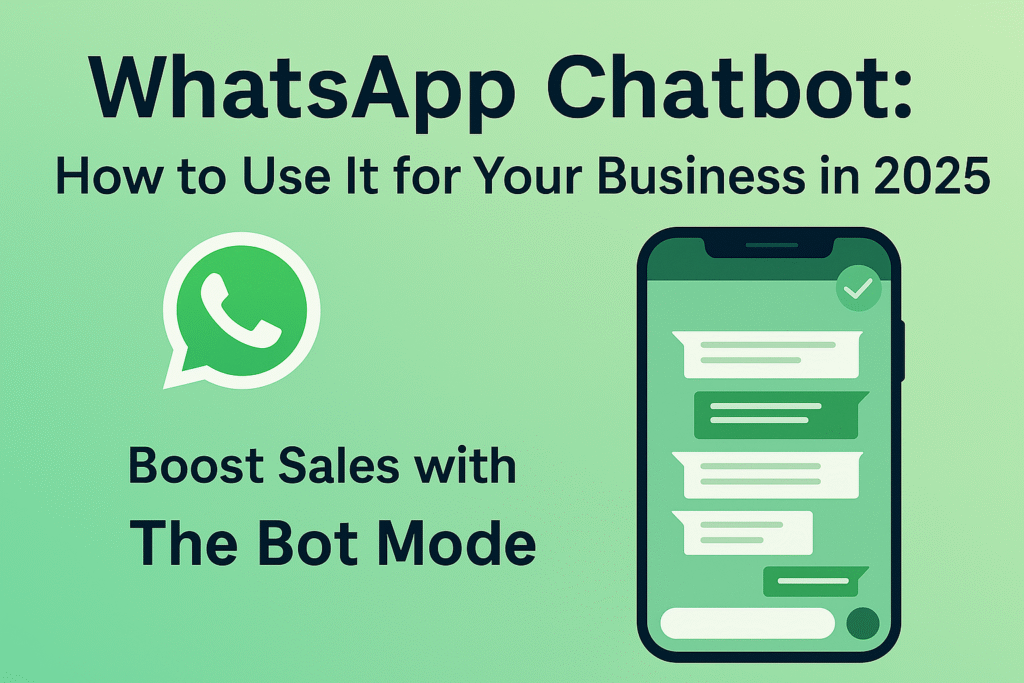
In 2025, WhatsApp chatbots are revolutionizing how businesses interact with customers. With over 2 billion active users, WhatsApp has become the world’s most powerful communication platform—making it a game-changer for customer engagement, automation, and sales. At The Bot Mode, we empower businesses to build custom WhatsApp chatbots that automate lead generation, support, and conversion—without any coding. What Is a WhatsApp Chatbot? A WhatsApp chatbot is an automated assistant that interacts with customers via the WhatsApp Business API. These bots simulate human conversation and can: With The Bot Mode, your business can create a scalable and intelligent chatbot to operate 24/7—improving customer experience and driving results. Why Your Business Needs a WhatsApp Chatbot in 2025 1. 24/7 Instant Customer Support Your chatbot is always online—even when your human agents are not. This ensures instant responses and better customer retention. 2. Automated Lead Generation Capture, qualify, and nurture leads through conversational flows built specifically for your business goals. 3. Personalized Customer Interactions Use behavior data to send targeted messages, product recommendations, and follow-ups—resulting in higher engagement. 4. Save Time & Reduce Costs By automating repetitive conversations, your team can focus on high-value tasks—while the bot handles routine queries. 5. Scalable for All Sizes Whether you’re handling 10 or 10,000 conversations a day, The Bot Mode chatbot scales with your growth—without added cost or complexity. How to Set Up a WhatsApp Chatbot with The Bot Mode Step 1: Sign Up on TheBotMode.com Start by creating your free account. Access our intuitive dashboard and chatbot builder. Step 2: Get WhatsApp Business API Access The Bot Mode handles onboarding and verification to connect your number to Meta’s official API—unlocking full automation capabilities. Step 3: Build Your Custom Chatbot Flow Use our no-code drag-and-drop builder to design flows for: Step 4: Integrate with Your Tools Connect to Google Sheets, Shopify, WooCommerce, Razorpay, CRMs, and other platforms—without writing any code. Step 5: Launch, Monitor, and Optimize Publish your chatbot. Use real-time analytics to track performance, optimize flows, and improve customer satisfaction. The Bot Mode: Your WhatsApp Chatbot Partner The Bot Mode helps you launch high-converting, personalized WhatsApp chatbots that: Real-World Use Cases Compliance & Best Practices FAQs Q1. Can I use WhatsApp chatbots without coding? Yes. The Bot Mode offers a drag-and-drop builder that requires no technical skills to launch or manage. Q2. Is WhatsApp chatbot suitable for small businesses? Absolutely. Whether you’re a startup or an enterprise, The Bot Mode is built to support businesses of all sizes. Q3. Can I integrate this with my Shopify or WooCommerce store? Yes. The Bot Mode integrates seamlessly with eCommerce platforms to automate orders, confirmations, and product recommendations. Q4. Do I need WhatsApp Business API access? Yes. You must be approved by Meta to use the API, and The Bot Mode assists you with the entire onboarding process. Q5. How much does it cost to use The Bot Mode? We offer flexible pricing plans tailored to your scale—starting from small business plans to advanced enterprise solutions. Final Thoughts WhatsApp chatbots are not a futuristic luxury—they’re a necessity in 2025’s automation-first business environment. With the right strategy, you can automate conversations, enhance customer experience, and grow revenue—all inside WhatsApp. The Bot Mode gives you the tools to do all this—at scale, without complexity. Ready to automate your WhatsApp? Book a Free Demo with TheBotMode
How to Setup and Increase WhatsApp Message Sending Limit in 2025
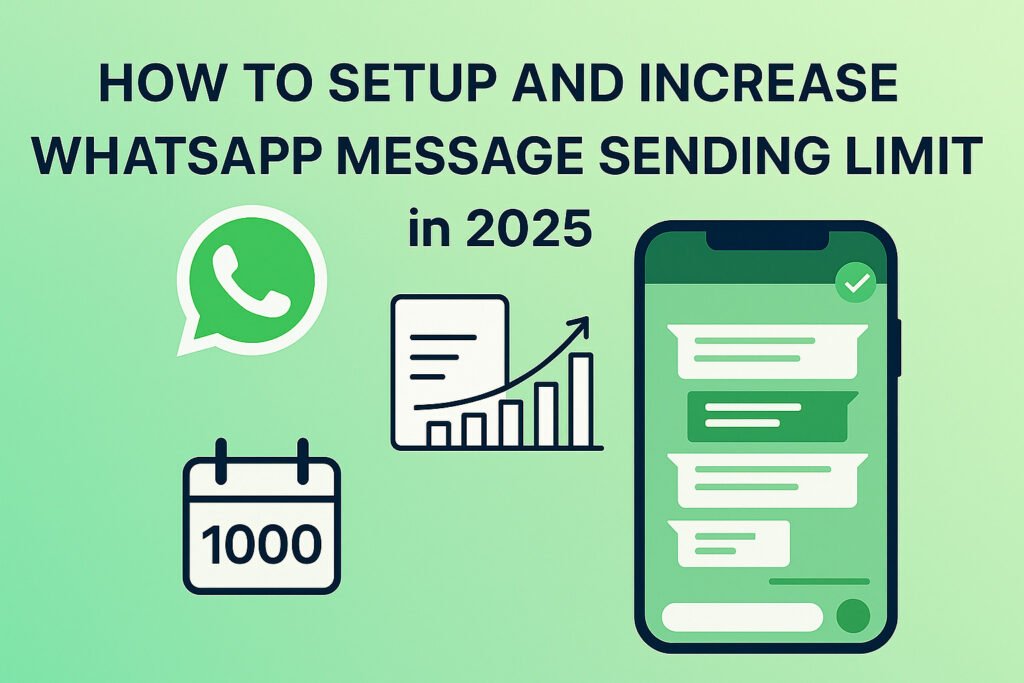
WhatsApp remains one of the most powerful tools for customer communication in 2025. But if your business relies on bulk messaging, you’ve likely hit a wall with WhatsApp’s daily message sending limits. Whether you’re using the official WhatsApp Business API or working with a BSP like The Botmode, understanding and increasing your messaging limits is key to scaling effectively. In this guide, you’ll learn: What Are WhatsApp Messaging Tiers? WhatsApp Business API accounts are grouped into tiers based on how many unique users they can message in a 24-hour period: Tier Limit per 24 Hours 1 1,000 unique users 2 10,000 unique users 3 100,000 unique users 4 Unlimited (based on conditions) Meta automatically upgrades your tier based on your activity, account quality, and engagement history. How to Set Up WhatsApp Business API (2025) If you’re new to WhatsApp Business API, here’s how to get started: 1. Verify Your Business 2. Choose a BSP (Business Solution Provider) To simplify integration, consider a BSP like The Botmode, which provides a UI, automation, and Shopify/WooCommerce integrations. 3. Set Up a Dedicated WhatsApp Number 4. Create and Submit Message Templates How to Increase WhatsApp Message Sending Limit To move from Tier 1 to higher tiers, you must show consistent volume and high-quality engagement. Here’s how: Send Consistent Message Volume Maintain a High-Quality Score Encourage Opt-Ins and Reduce Blocks Verify and Strengthen Your Brand Best Practices to Maintain a High-Quality Rating To keep your quality score in the green zone, follow these guidelines: Do This: Avoid This: Tip: Sustained low ratings may reduce your tier or lead to account suspension. How WhatsApp Determines Message Quality Meta evaluates your message quality based on: You can monitor your message quality in:Meta Business Manager → WhatsApp Manager → Phone Numbers Why Choose The Botmode for WhatsApp Automation? The Botmode helps D2C brands automate WhatsApp campaigns while maintaining compliance and maximizing ROI. With The Botmode, you can: Visit: thebotmode.com/whatsapp-automation Final Thoughts Scaling your WhatsApp messaging in 2025 is about consistency, compliance, and customer experience. Once your API is properly set up and your campaigns follow Meta’s best practices, you’ll naturally progress through higher messaging tiers. Tools like The Botmode make this journey faster, safer, and smarter. FAQs Q1: How often can my messaging tier be upgraded? Meta reviews accounts continuously. Upgrades can happen within 24 to 72 hours once your volume and quality meet the criteria. Q2: What’s the most common reason for tier downgrade? A high number of user blocks or reports can reduce your message quality score and result in a lower tier. Q3: Can I message users who haven’t opted in? No. WhatsApp requires clear opt-in consent before you can start a conversation.
Shop, Pay, Done!
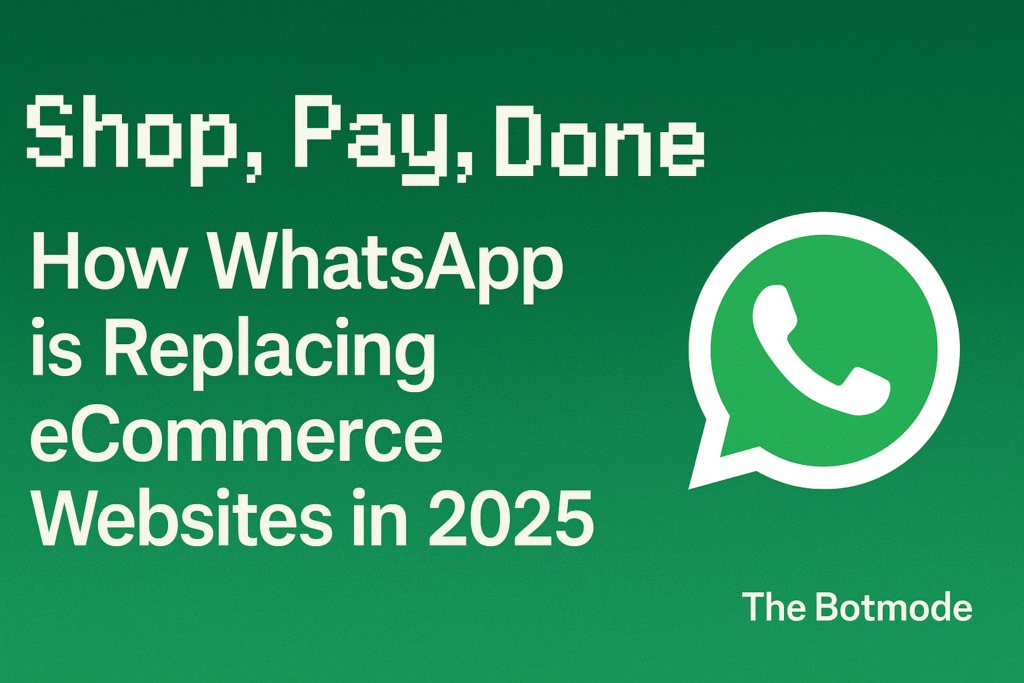
How WhatsApp is Replacing eCommerce Websites in 2025 Step 1: Product catalogue and adding to the cart Step 2: Adding Address Step 3: Prepaid Payment Options Order Confirmation The New Era of eCommerce is Here In 2025, the eCommerce landscape is undergoing a seismic shift. Traditional websites are no longer the primary touchpoints for online shopping. Instead, consumers are gravitating towards platforms that offer convenience, personalization, and immediacy. Enter WhatsApp—a platform that has evolved from a simple messaging app to a comprehensive shopping destination. At TheBotMode, we’ve been at the forefront of this transformation, helping D2C brands harness the power of WhatsApp to drive sales, enhance customer engagement, and streamline operations. Why WhatsApp? The Shift From Browsers to Chat-Based Shopping The Rise of Conversational Commerce Consumers crave real-time interactions. WhatsApp’s chat-based interface facilitates instant communication between brands and customers, making shopping more interactive and personalized. AI Chatbots as the New Shop Assistants With AI-powered chatbots, businesses can provide 24/7 customer support, answer queries, and guide users through the purchasing process—all within the WhatsApp platform. Trust, Familiarity & Convenience of WhatsApp WhatsApp’s widespread adoption means customers are already comfortable using it. Integrating shopping experiences into a familiar platform reduces friction and builds trust. Integrated Payments: How Transactions Are Now Seamless UPI, Debit Card, Credit Card WhatsApp now supports various payment methods, including UPI, Stripe, and other global wallets, allowing for seamless transactions within the app. One-Click Checkout Within Chats Customers can complete purchases without leaving the chat, streamlining the buying process and reducing cart abandonment rates. Security Features That Drive Trust End-to-end encryption and secure payment gateways ensure that transactions are safe, fostering customer confidence. Personalized Shopping Through AI-Powered Recommendations Customer Behavior Analysis Through WhatsApp Interactions By analyzing chat interactions, businesses can gain insights into customer preferences and tailor offerings accordingly. Smart Product Suggestions in Real Time AI algorithms can suggest products based on browsing history and previous purchases, enhancing the shopping experience. Role of Meta’s AI in Revolutionizing CX Meta’s advanced AI tools empower businesses to deliver hyper-personalized customer experiences, setting new standards in customer satisfaction. Impact on Traditional eCommerce Platforms Decline in Website Traffic and Conversion Rates As more consumers shift to WhatsApp for shopping, traditional eCommerce websites are experiencing decreased traffic and lower conversion rates. Brands Pivoting to WhatsApp-First Strategies Forward-thinking brands are adopting WhatsApp-first approaches, recognizing the platform’s potential to drive engagement and sales. The Cost Efficiency and Engagement Advantage Operating on WhatsApp reduces overhead costs associated with website maintenance and offers higher engagement rates due to its interactive nature. Small Business Empowerment Through WhatsApp Commerce Zero Dev Cost Setup for Shop Owners Platforms like TheBotMode enable small businesses to set up shop on WhatsApp without significant development costs. Direct Customer Relationship Building WhatsApp facilitates direct communication between businesses and customers, fostering stronger relationships and loyalty. Real-World Success Stories of 2025 Numerous small businesses have reported increased sales and customer satisfaction after integrating WhatsApp into their sales strategy. The One-App Future is Now WhatsApp is not just an alternative to traditional eCommerce platforms; it’s becoming the new standard. Businesses that adapt to this change are poised to thrive in the evolving digital marketplace. Frequently Asked Questions Can I really shop safely through WhatsApp? Yes, WhatsApp employs end-to-end encryption and secure payment gateways to ensure safe transactions. How do businesses set up a shop on WhatsApp? Businesses can use platforms like TheBotMode to integrate their product catalogs and set up automated chatflows for seamless shopping experiences. What payment methods are supported on WhatsApp in 2025? WhatsApp supports various payment methods, including UPI, Stripe, and other global wallets, facilitating smooth in-app transactions. Is WhatsApp replacing eCommerce platforms completely? While WhatsApp is becoming a dominant platform for online shopping, it complements rather than completely replaces traditional eCommerce websites. Is WhatsApp shopping available globally or region-specific? WhatsApp shopping features are expanding globally, with availability varying by region and integration partners.
WhatsApp Meets Shopify: A Game-Changer for D2C Brands
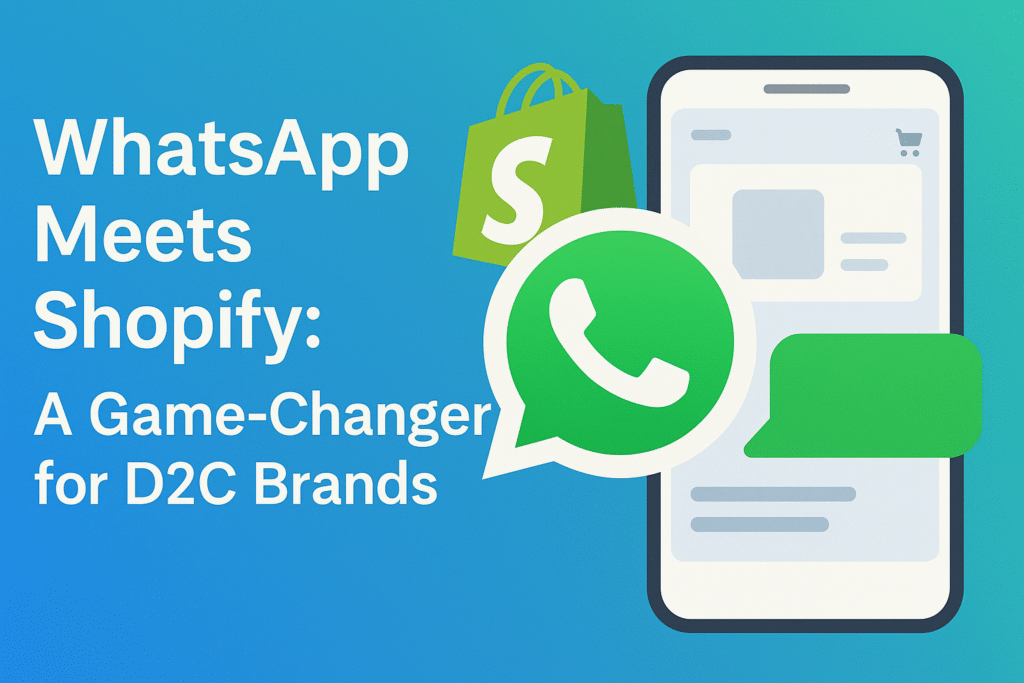
Introduction The Direct-to-Consumer (D2C) business model has exploded in recent years, reshaping how brands engage with consumers. Today’s digital-first shoppers demand instant responses, personalized interactions, and seamless purchasing experiences. For D2C brand owners, combining the power of Shopify’s ecommerce platform with WhatsApp’s direct messaging capabilities is proving to be a game-changer. Why WhatsApp Integration is Crucial for D2C Brands Direct & Instant Customer CommunicationWhatsApp allows D2C brands to connect with customers on a platform they already use daily. Instant messaging is far more effective than waiting for email responses or customer service calls. High Engagement Rates vs. Traditional Email MarketingCompared to email open rates, WhatsApp messages enjoy a staggering 98% open rate, ensuring your messages are not just delivered—but read. Personalized Shopping Experience in Real-TimeWith features like interactive product catalogs, direct replies, and media sharing, customers receive a personalized, concierge-like experience from your brand. How Shopify and WhatsApp Work Together Popular Tools & Plugins for IntegrationSeveral powerful solutions simplify the process of merging Shopify and WhatsApp. Tools like TheBotMode, offer plug-and-play functionality with advanced customization. Automated Notifications: Cart Recovery, Order Updates, etc.Once integrated, brands can automate key communications—abandoned cart reminders, order confirmations, shipping alerts, and more. Customer Support Chatbots within Shopify24/7 customer service is now possible through WhatsApp chatbots, helping customers with FAQs, product information, and order tracking—without human intervention. Top Benefits of WhatsApp Integration in Shopify for D2C Boost Conversion Rates with One-Click CheckoutSend dynamic product links and abandoned cart recovery prompts directly in WhatsApp, guiding users back to checkout with a single click. 24/7 Customer Service via WhatsApp BotsAutomated bots ensure your support line is always open, leading to higher satisfaction and trust. Build Loyalty with Personalized CampaignsSegmented broadcasts enable brands to deliver targeted offers and content to customers based on their behaviors and preferences. Retargeting and Broadcast FeaturesLeverage WhatsApp’s broadcast capabilities to retarget inactive customers, announce product launches, and promote flash sales. Step-by-Step Guide to WhatsApp Integration in Shopify 1. Choose the Right WhatsApp Business API ProviderSelect from reputable providers like TheBotMode, Interakt, or WATI that offer seamless integration with Shopify. 2. Install and Configure the App on ShopifyInstall the chosen app, follow setup instructions, and link your WhatsApp Business account. 3. Customize Flows and Templates for Brand VoiceDesign message templates for onboarding, upselling, order updates, and more—aligned with your unique brand voice. Real Use Cases from Leading D2C Brands Case Study: Increased Sales through Abandoned Cart RecoveryA D2C fashion brand integrated WhatsApp with Shopify and recovered 35% more abandoned carts using personalized WhatsApp messages. Case Study: Customer Retention through Personalized CampaignsA skincare brand used WhatsApp to send customized product recommendations based on past purchases, leading to a 28% increase in repeat orders. Common Mistakes to Avoid Over-Automation without Human BackupAutomation is powerful but should be balanced with human support to handle complex queries. Ignoring Opt-in ComplianceEnsure customers opt-in for WhatsApp communications to remain compliant with privacy regulations. Underutilizing Analytics and FeedbackRegularly analyze WhatsApp interaction data to refine your campaigns and engagement strategies. Future of D2C Commerce with WhatsApp & Shopify AI-driven Personalized ShoppingExpect hyper-personalized experiences powered by AI analyzing user behavior in real time. Unified Omnichannel Customer JourneysWhatsApp, email, SMS, and Shopify will function in harmony to deliver a unified customer experience. Voice & Video Integration PotentialEmerging features like voice commerce and video consultations may soon integrate into WhatsApp, creating richer customer touchpoints. Conclusion For D2C brand owners, integrating WhatsApp into your Shopify store isn’t just a smart move—it’s becoming a necessity. The ability to communicate, sell, and support customers in real time offers unmatched value. Tools like TheBotMode make it easier than ever to deploy these features and elevate your customer experience. Ready to level up your D2C strategy? Embrace WhatsApp integration in Shopify and start seeing the difference. FAQs What’s the best tool for WhatsApp integration in Shopify?TheBotMode, Interakt, and WATI are highly rated for ease of use and powerful automation. Can I automate customer responses on WhatsApp in Shopify?Yes, using WhatsApp Business API and tools like TheBotMode, you can deploy chatbots and automated flows. Is WhatsApp Business API secure and compliant?Yes, it adheres to global data protection standards and requires user opt-in for communications. How can I use WhatsApp for marketing my D2C products?Send personalized offers, launch announcements, and product recommendations through targeted broadcasts.
Is WhatsApp the New SMS for Businesses? Here’s Why Your D2C Brand Can’t Afford to Ignore It
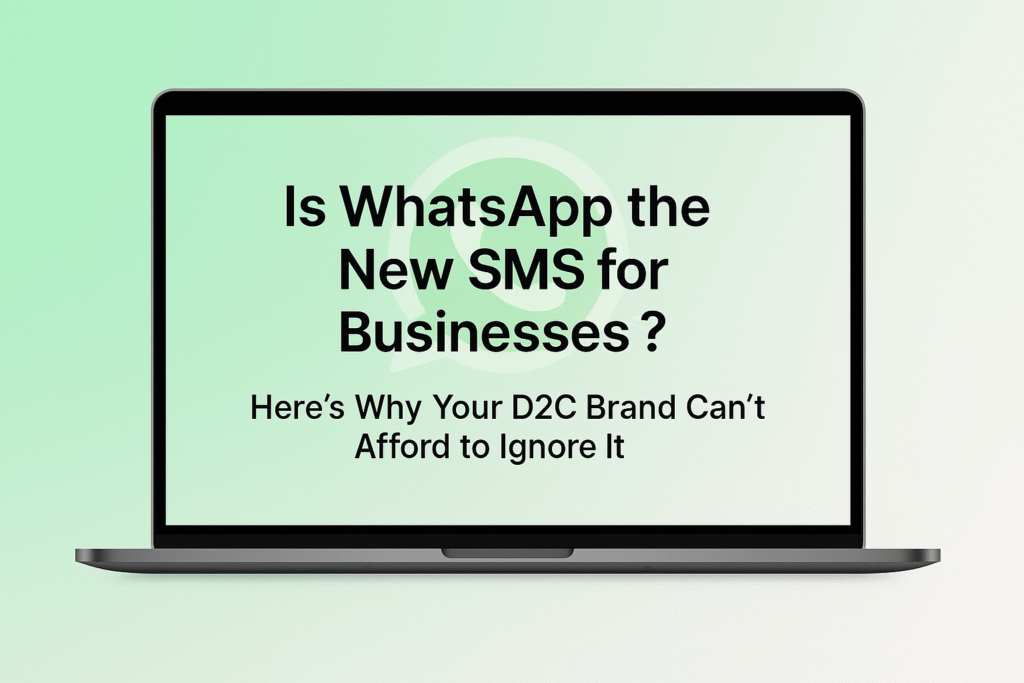
Remember the good old days of SMS? For years, it was the go-to for quick updates and business alerts. If you wanted to reach someone directly on their phone, SMS was king. But let’s be honest, when was the last time an SMS from a brand truly excited you? Times are changing, and so are customer expectations. There’s a new powerhouse in town for business communication, one that’s probably already your go-to for chatting with friends and family: WhatsApp. And if you’re a Direct-to-Consumer (D2C) brand in today’s competitive market, overlooking WhatsApp isn’t just a missed opportunity – it’s like willingly letting your competitors sprint ahead. Feeling a bit of FOMO? You should be, and here’s why. The Communication Shift: Customers Want More Than Just Text Think about how you communicate. You share photos, videos, voice notes, and expect quick replies. Your customers are no different. They crave connection, convenience, and conversations that feel personal, not like they’re just another number on a broadcast list. This is where traditional channels like SMS are starting to show their age for D2C brands: Your customers are already on WhatsApp – billions of them, in fact. They use it daily, trust it, and are comfortable interacting on it. So, why aren’t you meeting them where they are, in a way that feels natural and engaging? Why WhatsApp is a Game-Changer for Your D2C Brand For D2C brands, building a direct relationship with customers is everything. WhatsApp, especially when powered by the WhatsApp Business API, isn’t just another channel; it’s a relationship-building platform. Unlocking WhatsApp’s Full Potential: Meet the WhatsApp Business API (and The Botmode!) Now, you might be thinking, “I use WhatsApp Business already, what’s different?” The standard WhatsApp Business app is great for very small businesses. But to truly scale your WhatsApp marketing, manage conversations efficiently, automate responses, and integrate with your eCommerce backend, you need the WhatsApp Business API. This is where solutions like The Botmode step in. We help D2C brands like yours unlock the full power of the WhatsApp Business API without the technical headaches. Imagine: The Botmode is designed to make business communication on WhatsApp seamless, effective, and incredibly powerful for D2C brands looking to grow. Worried About a Steep Learning Curve or Annoying Customers? Two common concerns we hear are: “Is this going to be complicated to set up?” and “Will I end up annoying my customers?” The Future is Conversational – And It’s Happening on WhatsApp The trend is clear: conversational commerce is not just a buzzword; it’s the future. Customers want to interact with brands the same way they chat with friends. They want their queries answered instantly, their shopping experiences to be seamless, and their interactions to be personal. WhatsApp is at the forefront of this revolution. D2C brands that embrace it now are positioning themselves to build stronger customer relationships, drive more sales, and create a loyal community. Those who wait risk being drowned out by the noise of outdated channels. Don’t Get Left Behind – It’s Time to Chat! If you’re still relying solely on email and SMS, it’s time to ask yourself: are you truly meeting your customers where they are? Are you offering them the engaging, instant, and personal communication they expect? WhatsApp is no longer just a “nice-to-have” for D2C brands; it’s a fundamental part of a winning customer engagement strategy. Ready to transform your customer communication and see what WhatsApp can really do for your D2C brand? Explore how The Botmode can help you harness the power of the WhatsApp Business API. Let’s start a new conversation with your customers – one they’ll actually look forward to.
WhatsApp Template Rejected? Here’s How to Fix It Fast

If you’ve ever submitted a WhatsApp message template only to find it rejected by Meta, you’re not alone. Many businesses, especially those using the WhatsApp Business API for the first time, run into this issue. At TheBotMode, we help D2C brands streamline WhatsApp marketing campaigns. One of the most common roadblocks is template rejection. The good news? Most rejections are easily fixable—once you understand the root cause. This guide will walk you through: Why Your WhatsApp Template Was Rejected Meta uses both automated systems and human reviewers to evaluate message templates. Below are the most common reasons for rejection: 1. Promotional Language in Utility Templates If your message includes terms like “Get 50% off” or “Click to buy now” but is submitted as a Utility template, it will be rejected. Use the Marketing category for promotional content. 2. Spelling or Grammar Errors Templates with typos, informal tone, or poor grammar are often rejected. Keep messages professional and well-written. 3. Incorrect Variable Formatting All variables must follow the correct format, such as {{1}}. Avoid missing braces, extra spaces, or incorrect placements. 4. Use of Prohibited Terms Avoid sensitive topics related to politics, health, finance, or exaggerated claims such as “100% guaranteed” or “COVID-safe.” 5. Vague or Misleading Messaging If the message lacks context or is too ambiguous, Meta may reject it. Be specific and align your message with the chosen category. How to Fix a Rejected WhatsApp Template A rejection isn’t the end — it’s simply feedback. Follow these steps to fix and resubmit: Step 1: Read the Rejection Note Meta usually includes a brief explanation. Use this to identify the problem. Step 2: Identify the Mistake Check for: Step 3: Edit and Resubmit Make the necessary changes: Key Changes Introduced by Meta (Updated 2025) Meta recently introduced stricter rules to improve template quality. These updates are already being tested across selected WABAs: These changes are designed to improve deliverability, platform performance, and user experience. At TheBotMode, we are fully aligned with these changes. If a WABA under this restriction submits a non-compliant template, our system will return the rejection reason as:“The Body (or Content) field can’t have more than 550 characters.” Note: Existing approved templates are not affected by this policy, even if they exceed the new limits. WhatsApp Template Approval Checklist Before submitting, ask yourself: What If a Template Is Blocked After Approval? Meta continues to monitor template performance even after approval. If quality degrades, your template may be paused or blocked. Template Quality Ratings: Common Reasons for Blocking: How to Resolve It: Helpful Tools from TheBotMode TheBotMode offers features to help you create compliant, high-performing templates: Conclusion A rejected WhatsApp template is not a failure — it’s an opportunity to improve. With a little editing and the right support, most issues can be resolved quickly. With TheBotMode’s tools and guidance, D2C brands can reduce template rejections, stay compliant with Meta’s policies, and run smooth, scalable WhatsApp campaigns. Need assistance? Our team is here to help you fix, optimize, and launch WhatsApp messages with confidence. FAQs 1. How long does it take for Meta to review a WhatsApp template? Most templates are reviewed within minutes to a few hours. Obvious rejections happen faster. 2. Can I reuse the name of a rejected template? No. Each template name must be unique, even if the previous one was rejected. 3. What are the valid WhatsApp template categories? 4. How do I check my template’s quality rating? Log in to Meta’s WhatsApp Business Manager → Go to Message Templates → Check the status indicator next to each template.













